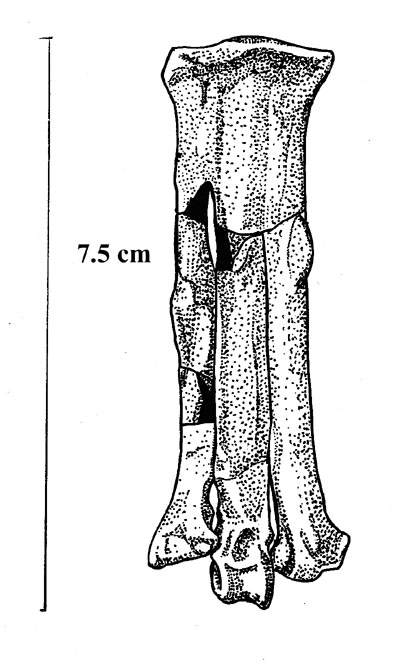
Species: archibaldi BRETT-SURMAN & PAUL, 1985
Etymology: In honor of David Archibald, its discoverer.
Holotype: University of California (Berkeley) Museum of Paleontology, UCMP 117600
Location: University of California (Berkeley) Museum of Paleontology, UCMP Locality V73097, Garfield County, Montana.
Horizon: Hell Creek Formation.
Biostratigraphy:
Age: Lancian age, upper Maastrichtian Stage, uppermost Senonian subepoch, Upper Gulf Epoch, Late Cretaceous.
Material: Left Metatarsus.

Paratype:
YPM 17324: Isolated right metatarsus.
Referred material:
STIDHAM & HUTCHISON, 2001
Locality: Montana.
Horizon: Hell Creek Formation.
Biostratigraphy:
Age: Lancian age, upper Maastrichtian Stage, uppermost Senonian subepoch, Upper Gulf Epoch, Late Cretaceous.
Material:
Number: Not given: A large distal tibiotarsus.
= cf. Avisaurus archibaldi LONGRICH, TOKARYK & FIELD, 2011
YPM 57235: Large coracoid.
_____________________________________________________________________________________
Species: gloriae VARRICCHIO & CHIAPPE, 1995
Etymology: In recognition of Gloria Siebrecht, who has contributed countless
volunteer hours to the MOR both in the field and in the preparation of specimens
and whose keen eye discovered this specimen.
= Avisaurus sp VARRICCHIO, 1995
Holotype: MOR-553E
Locality: MOR Locality TM-068, Birthday Site, Glacier County, Montana.
Horizon: Two Medicine Formation.
Biostratigraphy:
Age: Judithian age, Campanian Stage, Senonian subepoch, Upper Gulf epoch, Late Cretaceous.
Material: Right tarsometatarsus.
Note: Half the size of type.